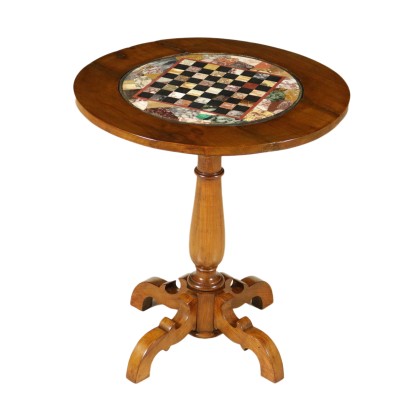Table of "committed"
Features
Age: 19th Century / 1801 - 1900
Year: 1867
Origin: Toscana, Italy
Main essence: Cherry
Material: Marble
Description
The table right from the leg the turned, ending with all four feet moved. A round top with a central flat marble inlaid committed with the board. Engraved on the back "Domenico Betti 1867".
Product Condition:
Product that shows signs of wear due to age. Requires small restoration interventions.
Dimensions (cm):
Height: 75
Diameter: 69
With certificate of authenticity
Additional Information
Notes historical bibliographic
The inlaid marble to the clerk, to mo' of the chessboard, presents inserts of malachite, the green marble of the Alps, breccia medicea, and more. In relation to the technique of "committed" deriving from the ancient Opificio delle pietre dure in Florence, is the quote of the workshop conducted by Francesco Betti mosaicist, active in Florence from 1848 to 1884. The workshop, in 1867, has a population of about thirty workers and in the same year, he participates at the universal exhibition in Paris. The workshop had two offices: one in Lungarno New, the other in the edge of all saints. And' likely to assume that the above-mentioned Domenico Betti it was a relative of the owner and mosaic artist. Information taken from "Furniture manufacturer tuscany" by Simone Chiarugi, edizioni S. P. E. S, Volume II, page 420.Age: 19th Century / 1801 - 1900
19th Century / 1801 - 1900Main essence: Cherry
Obtained from prunus cerasus , a plant of oriental origin, it is a hard wood with a light and delicate color, with a reddish vein. Due to its diffusion and availability it was used in Europe in popular furniture. In cabinet making, in the seventeenth century, it was widely used in France and England for inlay work. In Italy it was very successful in Lucca. It was also very popular in the United States for the manufacture, from the late 1600s, of commonly used furniture.The dictionary of antiques: Eclecticism
Classic Monday: a sofa from the 1800s example of eclecticism



























